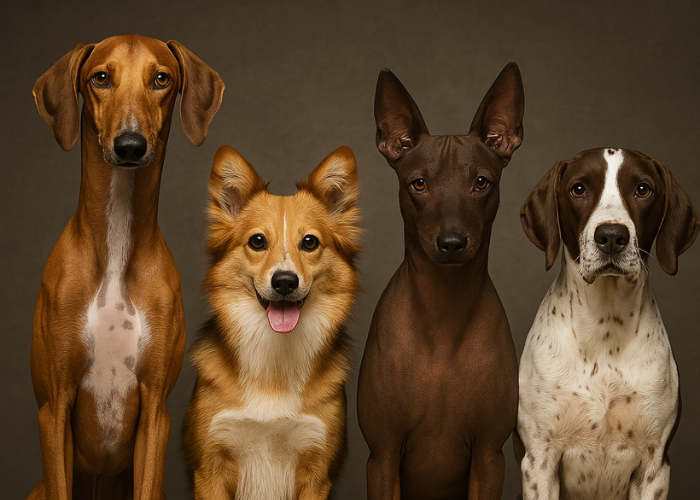Have you ever seen a dog react with overwhelming joy when reuniting with someone after years apart? Their tail wags, excited barks, and bounding leaps say it all: dogs never forget those they love.
But how exactly do dogs recognize people or other dogs after long periods without contact? The answer lies in their powerful sense of smell, emotional memory, and social instincts. Let’s break down the science behind your dog’s unforgettable memory.
👃 The Incredible Power of a Dog’s Sense of Smell
Dogs experience the world primarily through their nose. Their sense of smell is 10,000 to 100,000 times stronger than that of humans, making scent their most reliable memory trigger.
What makes their nose so powerful?
- Dogs have up to 300 million olfactory receptors, compared to 5–6 million in humans.
- The part of the brain dedicated to smell is 40 times larger than in humans.
When a dog meets someone — human or canine — they imprint that individual’s unique scent into memory. This scent becomes a “scent fingerprint”, linked with emotional experiences. Even after years apart, a single whiff can trigger a joyful memory and instant recognition.
👁️ Visual Recognition: More Than Just Faces
Though smell dominates, dogs also use their eyes to recognize familiar beings. While their vision isn’t as sharp as ours, they excel at detecting movement, shapes, and body language.
Dogs can:
- Recognize familiar faces, even if someone changes over time (e.g. gains a beard, wears glasses)
- Identify people and pets by the way they walk or move
- Respond to familiar gestures or postures, not just appearance
So when your dog spots an old friend walking in a familiar way, they may recognize them before getting close enough to smell.
❤️ Emotional and Associative Memory
Dogs don’t just remember what they experience — they remember how it made them feel. Their memory is emotional and associative, which means they link people, places, and scents to how those experiences made them feel.
Examples of emotional memory:
- A dog who had a loving owner years ago may instantly show excitement upon seeing them again.
- A previously negative interaction can trigger fear or hesitation, even after a long time.
That’s why reunions are so powerful: dogs aren’t just recognizing a person — they’re recalling all the feelings that came with them.
👂 Recognition Through Sound and Voice
Dogs have highly sensitive hearing and can detect frequencies beyond human range. Even more impressively, they can recognize specific voices and tones.
Over time, your voice becomes part of your dog’s emotional memory. So even if they can’t see or smell you right away, just hearing your voice can trigger joy, excitement, or curiosity.
This is especially helpful when:
- Reuniting at a distance (calling their name)
- Talking to your dog over a phone or video call
- Using familiar phrases or cues
🐕 Social Instincts: The Pack Mentality
Dogs are natural pack animals. This instinct leads them to form deep, lasting social bonds with their human family and other animals they consider part of their “pack.”
This bond is reinforced through:
- Daily interaction and positive reinforcement
- Physical affection and touch
- Shared routines and environments
Even if a dog is separated from their pack for years, the emotional connection remains. That’s why many dogs react as if no time has passed when reunited with a former owner or a long-lost canine sibling.
👶 Experience and Training Shape Recognition
Just like humans, dogs learn from experience. A dog that’s been well-socialized from a young age is more likely to recognize others later in life.
Additionally, dogs trained for specific roles — such as service dogs or search-and-rescue canines — develop even sharper recognition skills. They are trained to focus on:
- Specific scents
- Voices
- Body language and movements
This training enhances their natural memory and strengthens their ability to recognize individuals over time.
🔁 How Dogs Remember: A Summary of Their Super Senses
| Sense | Role in Recognition |
|---|---|
| Smell | Most powerful memory trigger; unique scent recognition |
| Sight | Movement, body language, and facial recognition |
| Hearing | Voice and tone recognition, even at a distance |
| Emotional Memory | Links people and pets to feelings and experiences |
| Instinct | Strong pack bonding reinforces long-term memory |
🙋♂️ Frequently Asked Questions
1. Can dogs really remember someone after years?
Yes! Thanks to emotional and scent-based memory, dogs can remember people — especially those they had strong bonds with — even after several years.
2. How do dogs recognize other dogs?
Primarily through scent. Every dog has a distinct smell that’s stored in memory. They may also use visual and behavioral cues.
3. Will my dog forget me if I’m away for a long time?
It’s unlikely. Dogs form strong emotional connections with their owners. If the bond was positive, your dog is very likely to remember you through scent, sound, and body language.
4. Can dogs recognize family members like siblings or parents?
Yes — especially if they were raised together. Scent and shared early experiences play a big role in this recognition.
5. How can I help my dog remember me during long separations?
Leave behind a scented item like a worn shirt. Upon reunion, use familiar words and your voice to help spark emotional memory.
🐾 Final Thoughts: Dogs Never Forget the Ones They Love
A dog’s ability to remember people and pets is one of the many ways they show us just how deep their loyalty and affection run. Their powerful senses, emotional intelligence, and pack-driven nature allow them to hold onto memories of love, comfort, and connection — even after years apart.
So whether it’s the sound of your voice, the scent of your skin, or the joy of seeing your face, your dog remembers you — and always will.
That’s just one more reason to treat your furry friend with the love, kindness, and respect they so richly deserve.



